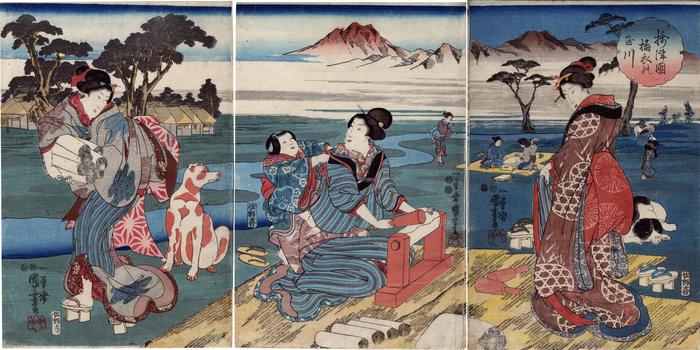Utagawa Kuniyoshi (歌川国芳) (artist 11/15/1797 – 03/05/1861)
The Cloth-fulling Jewel River in Settsu Province (Settsu no kuni Tōi no Tamagawa - 摂津国檮衣の玉川) from an untitled triptych series of Six Jewel Rivers (Mu Tamagawa - 六玉川)
1847
14.75 in x 30 in (Overall dimensions) Japanese color woodblock print
Signed: Ichiyūsai Kuniyoshi ga
一勇斎国芳画 on each sheet
Artist's seal: kiri
Publisher: Sanoya Kihei (Marks 446 - seal 25-210)
Censor seals: Hama and Kinugasa
Museum of Fine Arts, Boston
British Museum
Rijksmuseum
National Diet Library
Museum für angewandte Kunst, Vienna - right panel
Museum für angewandte Kunst, Vienna - middle panel
Museum für angewandte Kunst, Vienna - left panel
Lyon Collection - another copy of this triptych
Museum of Oriental Art, Venice (via Ritsumeikan University) - right panel only
British Museum
Dayton Art Institute - left panel only
Tokyo Metropolitan Library
Nationaal Museum van Wereldculturen (Rijksmuseum Volkenkunde, Leiden) via Ritsumeikan University - right-hand panel only
Nationaal Museum van Wereldculturen (Rijksmuseum Volkenkunde, Leiden) via Ritsumeikan University - center panel only
Nationaal Museum van Wereldculturen (Rijksmuseum Volkenkunde, Leiden) via Ritsumeikan University - left-hand panel only
Victoria and Albert Museum The curatorial files at the Museum für angewandte Kunst in Vienna says:
"Series with triptychs on the six jewel rivers (Mu-Tamagawa 六 玉川), due to of their clear water were so named. The title appears in a cartouche that is shaped like a snow crystal. Here the Tamagawa from Mishima in the province of Settsu 摂 津 (near Kyoto). The river is also called the Tōi river (tōi = knocking a fabric with a kind of mallet), because here is a center of the production of substances and the water of the river is used for washing and tapping the substances. The picture shows a woman standing on spread straw mats. Her wooden sandals (geta), which she has stripped off, are next to the mat. In front of her on the floor are two wooden mallets for tapping the fabrics. The women in the background are currently working on the fabrics. A river landscape and a mountain range in the distance. which stands on spread straw mats. Her wooden sandals (geta), which she has stripped off, are next to the mat. In front of her on the floor are two wooden mallets for tapping the fabrics. The women in the background are currently working on the fabrics. A river landscape and a mountain range in the distance. which stands on spread straw mats."
****
The curatorial files at the Museum für angewandte Kunst in Vienna says:
"Series with triptychs on the six jewel rivers (Mu-Tamagawa 六 玉川), due to of their clear water were so named. The title appears in a cartouche that is shaped like a snow crystal. Here the Tamagawa from Mishima in the province of Settsu 摂 津 (near Kyoto). The river is also called the Tōi river (tōi = knocking a fabric with a kind of mallet), because here is a center of the production of substances and the water of the river is used for washing and tapping the substances. The picture shows a woman standing on spread straw mats. Her wooden sandals (geta), which she has stripped off, are next to the mat. In front of her on the floor are two wooden mallets for tapping the fabrics. The women in the background are currently working on the fabrics. A river landscape and a mountain range in the distance. which stands on spread straw mats. Her wooden sandals (geta), which she has stripped off, are next to the mat. In front of her on the floor are two wooden mallets for tapping the fabrics. The women in the background are currently working on the fabrics. A river landscape and a mountain range in the distance. which stands on spread straw mats."
****
On the bank of the Tōi Crystal River, a woman kneeling by a fulling-block beating cloth. A child behind her. A woman on the left is taking away rolls of cloth that have already been treated. Village houses in the distance.
****
On page 5 of Amy C. Riggs' September 2017 doctoral dissertation from Princeton she wrote about fulling in ancient China. She noted: "By the Tang dynasty, fulling cloth has become a common poetic trope. As poets freely adopted the sight and sound of fulling cloth, it came to signify a soldier's longing for home, wistfulness for those who were away, the advent of autumn, and pending departure of dear ones."
****
The Tōi Jewel River is the furthest south of the six, name-related, rivers. They "...were famous in Japan for their pure, clear waters. Although geographically far apart, they shared a common name, and their peculiarities and poetic pseudonyms were often used as the titles in series of six prints."
Quoted from: Playthings and Pastimes in Japanese Prints by Lea Baten, p. 144.
Minamoto Shunrai (1055?-1129?) wrote:
Whispering wind in ancient pines****
desolate autumn
in the village by the Jewel river
where clothes are wrung.
"The catalogue of the Baur Collection, Geneva, illustrates all six triptychs in what is in effect a series, though it does not have a title... Each displays the name of the province and that of the Jewel river within a snowflake-shaped cartouche."
Quoted from: Kuniyoshi from the Arthur R. Miller Collection by Timothy Clark, p. 162.
****
llustrated in color in Japanese Prints: Images of the Floating World, Barry Davies Oriental Art, #77, illustrated on p. 99.
Sanoya Kihei (佐野屋喜兵衛) (publisher)
beautiful woman picture (bijin-ga - 美人画) (genre)
boshi-e (母子絵) (genre)
landscape prints (fūkeiga 風景画) (genre)
mitate-e (見立て絵) (genre)
